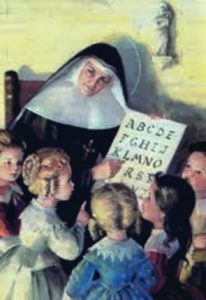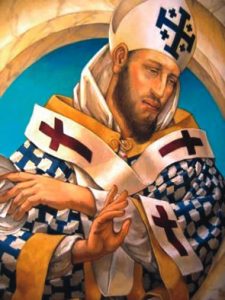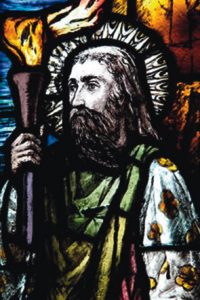March Saints
 Saint Jeanne de Lestonnac
Saint Jeanne de Lestonnac
(1556-1640)
Born in Bordeaux, France, in1556, Jeanne was the eldest of the family. Her father was a fervent Catholic, her mother a convinced Calvinist. Jeanne was drawn to Catholicism, while her mother continually tried to undermine the child’s faith. In the end, Jeanne opted to follow her father, and an interior voice confirmed her choice: “Be careful, daughter. Don’t let the fire that I have enkindled in your heart ever die out.”
While she would have loved to become a religious, this did not seem possible. So in 1572, in response to her father’s bidding, she married Gaston de Monferrat, to whom she bore seven children. Five of them survived. Widowed at the age of 41, Jeanne managed the affairs of her estate and castle by herself. Two of her daughters entered religious life and in 1603, Jeanne decided to enter the Cistercian monastery in Toulouse, where the harsh regimen of life caused her to become seriously ill. She wanted to die in the convent, but her superiors recognised God’s hand in her illness and encouraged her to found an order of women devoted to Our Lady. The moment she left the convent she miraculously recovered.
Jeanne gathered some young girls about her, and spent two quiet years in preparation. When the plague hit Bordeaux in 1605, they served as nurses. Some priests saw the need for an order to educate girls in the faith and counteract the influence of Calvinism. Under their guidance and with the support of the local Bishop, the Daughters of Our Lady were founded in 1610. The congregation was affiliated with the Benedictines, but the Rule was founded on that of St Ignatius Loyola.
As with all foundresses, there were troubles ahead. The Archbishop resented Jeanne’s efforts to gain extradiocesan freedom, and one of her Sisters displaced her as superior. For three years Jeanne was humiliated, but her great meekness triumphed and she was reconciled to her persecutor. No longer wishing to work as mother superior, Jeanne spent the remaining years of her life visiting houses of the congregation and setting its spirit firmly in the members. Two of her daughters and at least one granddaughter joined the Congregation. Jeanne died in 1640.
Saint Jeanne, help us to be sensitive to the movement of the Holy Spirit in our lives.
(Source: Internet – various)
 Saint Cyril of Jerusalem
Saint Cyril of Jerusalem
(315 – 386)
Historians estimate Saint Cyril was born about 315 and that he was brought up in Jerusalem. All we know of his family is that his parents were probably Christians and he seemed to care for them a great deal.
After being ordained a deacon and then a priest, Bishop Maximus put him in charge of the instruction of catechumens. When Maximus died, Cyril was consecrated as bishop of Jerusalem. When a famine hit Jerusalem, the poor turned for help to Cyril who, having no money, sold some of the Churche’s goods. A fallout with an Arian bishop saw him exiled more than once. On the death of this bishop, Cyril returned to Jerusalem, only to be exiled again by the Emperor’s consul.
Eleven years later, Cyril was allowed to go back to find a Jerusalem destroyed by heresy and strife. He was never able to put things completely right. He did attend the Council at Constantinople in 381 where the Nicene Creed and orthodoxy triumphed, Arianism was finally condemned and Cyril received justice. He had eight years of peace, and died in 386, at about seventy years old.
Saint Cyril, teach us to be steadfast in the face of persecution.
(Source: http://www.catholic.org/saints/saint.php?saint_id=40)
 Saint Enda
Saint Enda
(d. c. 530)
Enda was a young Irish warrior, intent upon war and the slaughter of his enemies, succeeding his father as king and going off to fight his enemies. Coming back from a bloody battle, he stopped by his sister’s convent. Fanchea faced her brother and told him his hands were dripping with blood and that he should turn his mind to things spiritual. He promised to amend his ways but, soon after, his promised bride-to-be died.
Faced with the reality of death, Enda decided to study for the priesthood, and in Candida Casa in Roman Britain, he took monastic vows and was ordained. On returning to Ireland he received a grant of land in the Aran Islands where he founded a monastery.
Enda died in his little rock cell by the sea around the year 530.
Saint Enda, show us the futility of earthly desires.
(Source: http://www.ewtn.com/library/MARY/ENDA.HTM)
 Entries(RSS)
Entries(RSS)